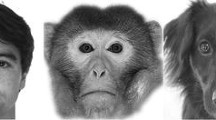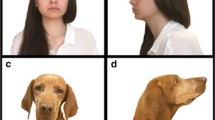Abstract
The ability of animals to use behavioral/facial cues in detection of human attention has been widely investigated. In this test series we studied the ability of dogs to recognize human attention in different experimental situations (ball-fetching game, fetching objects on command, begging from humans). The attentional state of the humans was varied along two variables: (1) facing versus not facing the dog; (2) visible versus non-visible eyes. In the first set of experiments (fetching) the owners were told to take up different body positions (facing or not facing the dog) and to either cover or not cover their eyes with a blindfold. In the second set of experiments (begging) dogs had to choose between two eating humans based on either the visibility of the eyes or direction of the face. Our results show that the efficiency of dogs to discriminate between “attentive” and “inattentive” humans depended on the context of the test, but they could rely on the orientation of the body, the orientation of the head and the visibility of the eyes. With the exception of the fetching-game situation, they brought the object to the front of the human (even if he/she turned his/her back towards the dog), and preferentially begged from the facing (or seeing) human. There were also indications that dogs were sensitive to the visibility of the eyes because they showed increased hesitative behavior when approaching a blindfolded owner, and they also preferred to beg from the person with visible eyes. We conclude that dogs are able to rely on the same set of human facial cues for detection of attention, which form the behavioral basis of understanding attention in humans. Showing the ability of recognizing human attention across different situations dogs proved to be more flexible than chimpanzees investigated in similar circumstances.




Similar content being viewed by others
References
Baldwin DA (1991) Infants’ contribution to the achievement of joint reference. Child Dev 63:875–890
Baron-Cohen S (1994) How to build a baby that can read minds: cognitive mechanisms in mindreading. Curr Psychol Cogn 13:513–552
Bodamer M, Gardner RA (2002) How cross-fostered chimpanzees (Pan troglodytes) initiate and maintain conversations. J Comp Psychol 116:12–26
Call J (2001) Chimpanzee social cognition. Trends Cogn Sci 5:388–393
Call J, Tomasello M (1994) Production and comprehension of referenial pointing by orangutans (Pongo pygmaeus). J Comp Psychol 108:307–317
Emery NJ (2000) The eyes have it: the neuroethology, function and evolution of social gaze. Neurosci Biobehav Rev 24:581–604
Hare B, Call J, Tomasello M (1998) Communication of food location between human and dog (Canis familiaris). Evol Commun 2:137–159
Hare B, Call J, Agnetta B, Tomasello M (2000) Chimpanzees know, what conspecifics do and do not see. Anim Behav 59:771–785
Heyes CM (1993) Anecdotes, training and trapping and triangulating: do animals attribute mental states? Anim Behav 46:177–188
Hostetter AB, Cantero M, Hopkins WD (2001) Differential use of vocal and gestural communication by chimpanzees in response to the attentional status of a human. J Comp Psychol 115:337–343
Itakura S, Tanaka M (1998) Use of experimenter-given cues during object choice tasks by chimpanzee (Pan troglodytes), and orangutan (Pongo pygmaeus) and human infants (Homo sapiens). J Comp Psychol 112:119–126
Kobayashi H, Kohshima S (1997) Unique morphology of the human eye. Nature 387:767–768
Langton SRH, Watt RJ, Bruce V (2000) Do the eyes have it? Cues to the direction of social attention. Trends Cogn Sci 4:51–58
Martin P, Bateson P (1986) Measuring behavior. Cambridge University Press, Cambridge, UK
Miklósi Á, Polgárdi R, Topál J, Csányi V (1998) Use of experimenter-given cues in dogs. Anim Cogn 1:113–121
Miklósi Á, Polgárdi R, Topál J, Csányi V (2000) Intentional behaviour in dog–human communication: an experimental analysis of ‘showing’ behaviour in the dog. Anim Cogn 3:159–166
Perrett DI, Smith AJ, Potter DD, Mistlin AJ, Head AS, Milner AD, Jeeves MA (1985) Visual cells in the temporal cortex sensitive to face view and gaze direction. Proc R Soc Lond B 223:293–317
Povinelli DJ, Eddy TJ (1996) What young chimpanzees know about seeing. Monogr Soc Res Child Dev 61:1–152
Povinelli DJ, Vonk J (2003) Chimpanzee minds: suspiciously human. Trends Cogn Sci 7:157–160
Povinelli, DJ, Dunphy-Lelii S, Reaux JE, Mazza MP (2002) Psychological diversity in chimpanzees and humans: new longitudinal assessment of chimpanzees’ understanding of attention. Brain Behav Evol 59:33–53
Soproni K, Miklósi Á, Topál J, Csányi V (2001) Comprehension of human communicative signs in pet dogs. J Comp Psychol 115:122–126
Soproni K, Miklósi Á, Topál J, Csányi V (2002) Dogs’ (Canis familiaris) responsiveness to human pointing gestures. J Comp Psychol 116:27–34
Theall L, Povinelli DJ (1999) Do chimpanzees tailor their gestural signals to fit the attentional states of others. Anim Cogn 2:207–214
Tomasello M, Call J, Nagell K, Olguin R, Carpenter M (1994) The learning and use of gestural signals by young chimpanzees: a trans-generational study. Primates 35:137–154
Tomasello M, Call J, Hare B (2003) Chimpanzees understand psychological states—the question is which one and to what extent. Trends Cogn Sci 7:153–156
Virányi Z, Topál J, Gácsi M, Miklósi Á, Csányi V (2003) Dogs respond appropriately to cues of human’s attentional focus. Behav Process (in press)
Acknowledgements
This study was supported by the Hungarian Academy of Sciences (F226/98) and an OTKA grant (T029705). We want to thank all the owners and their dogs at the Top Mancs Dog School for their devotion and endless patience while taking part in the tests. For comments on the manuscript, we thank Péter Pongrácz and we are grateful to Enikő Kubinyi and Tamás Ferenczy for taking and editing the photos. These experiments comply with the current laws of Hungary regarding the use of animals in research.
Author information
Authors and Affiliations
Corresponding author
Rights and permissions
About this article
Cite this article
Gácsi, M., Miklósi, Á., Varga, O. et al. Are readers of our face readers of our minds? Dogs (Canis familiaris) show situation-dependent recognition of human’s attention. Anim Cogn 7, 144–153 (2004). https://doi.org/10.1007/s10071-003-0205-8
Received:
Revised:
Accepted:
Published:
Issue Date:
DOI: https://doi.org/10.1007/s10071-003-0205-8




